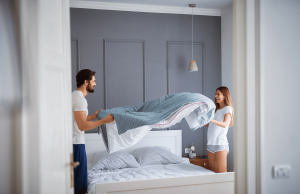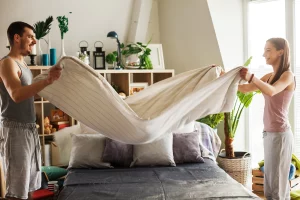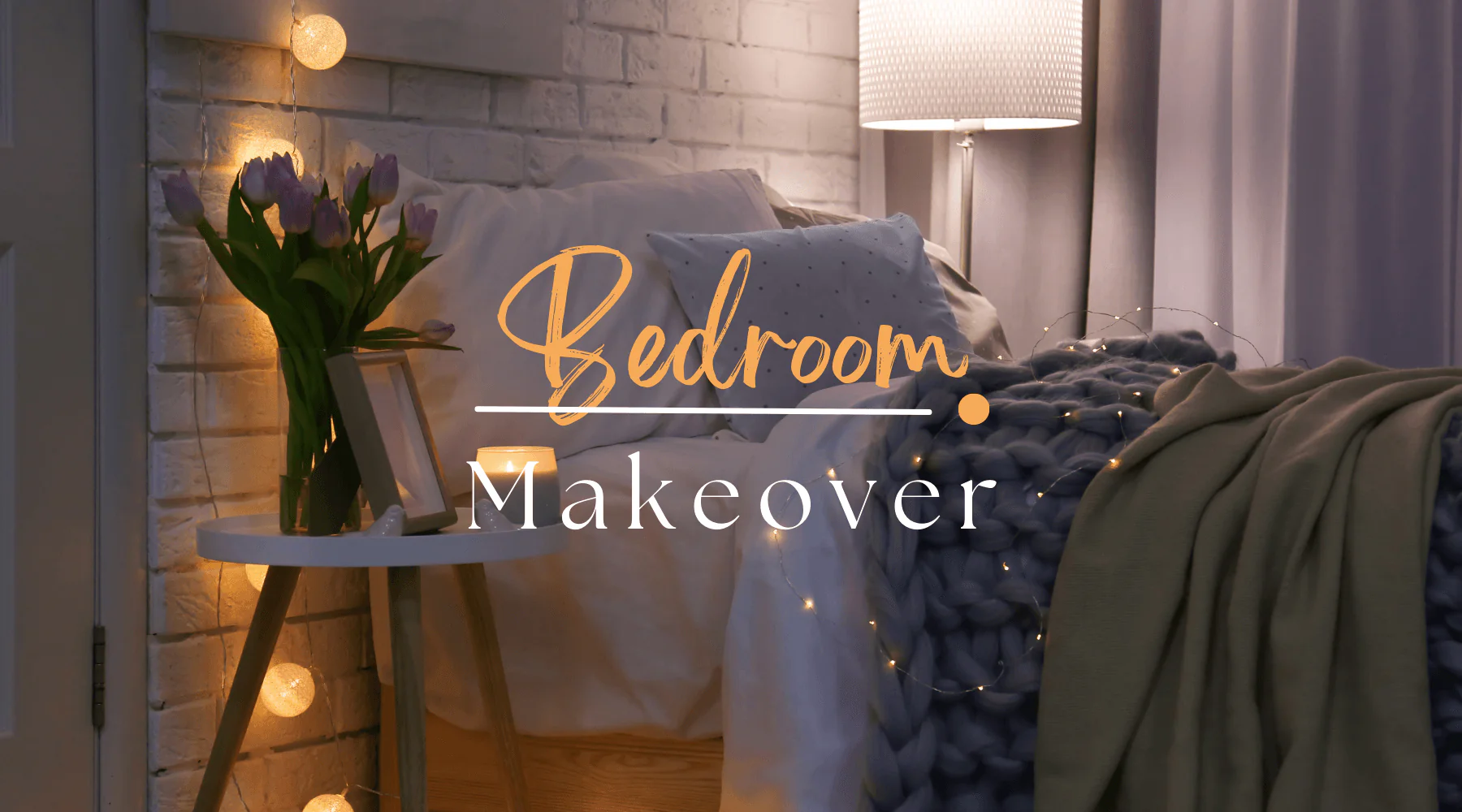Introduction
Your bedroom should be more than just a place to sleep. It should be a peaceful space where you can relax, recharge, and escape from the stress of daily life. A calm bedroom can help you sleep better, feel happier, and improve your overall health. Creating a relaxing bedroom is not just about decoration; it’s about making smart choices with lighting, colors, furniture, and the overall feel of the room.
A messy, cluttered bedroom can cause stress, while a tidy and calm space helps you relax. Whether you want to update your current bedroom or design a new one, this guide will show you easy ways to create a Relaxing Bedroom Retreat.
How to Design a Peaceful and Calming Bedroom

1. Choose Relaxing Colors
Colors affect how we feel. For a peaceful bedroom, use soft colors like light blue, green, lavender, beige, or gray. These colors are calming and help you relax. Avoid bright, loud colors that can make it harder to unwind.
If you like bright colors, try using them in small things like pillows or decorations, not on the walls. This keeps your room calm but still shows your personality.
2. Get Comfortable Bedding and Furniture
Comfortable bedding is key to a relaxing bedroom. Choose soft sheets made from cotton, linen, or bamboo. A mattress that is medium-firm is usually the best for sleep. Add soft pillows and blankets to make it even more cozy.
For furniture, go for simple, minimalist styles. Avoid too much furniture having space in the room helps keep it calm and peaceful.
3. Use Soft Lighting
Lighting is important for setting the right mood. Bright, harsh lights can make a room feel uncomfortable, but soft, warm lights make it cozy. Choose lamps with dimmers, fairy lights, or wall lights that can adjust to your mood.
Natural light is also important. Use light curtains to let in sunlight while still keeping your privacy. For nighttime, try smart bulbs with warm light to help you relax.
4. Keep Your Bedroom Tidy
A cluttered room can make it hard to relax. Keep your bedroom organized to help your mind stay calm. Here are some ways to do that:
- Store things out of sight, like under the bed or in storage boxes.
- Use shelves or tables that have extra storage space.
- If something takes less than a minute to put away, do it right away.
A clean, tidy room makes it easier to relax and sleep better.
5. Bring Nature into Your Bedroom
Adding natural elements can make your room feel calmer. Plants like lavender, aloe vera, or snake plants help clean the air and add a refreshing touch. Wood furniture, woven baskets, and stone decorations also help create a warm and peaceful feeling.
Decor with nature, like nature-themed pictures or rugs made from natural materials, helps make the room feel calm. You could also use a diffuser with relaxing scents like lavender to improve the atmosphere.
How to Improve Comfort and Sleep Quality

1. Keep the Temperature Comfortable
The right temperature helps you sleep better. Aim for a bedroom temperature between 60-67°F (15-20°C). Use breathable bedding to keep comfortable, and a fan or air purifier can help keep the air fresh.
2. Use Relaxing Scents
Certain scents, like lavender, chamomile, and sandalwood, are known to help you relax. Use an essential oil diffuser, candles, or pillow sprays to fill your room with these calming smells.
3. Limit Electronics
Electronics, like phones or TVs, can make it harder to sleep because they emit blue light. Try to avoid using screens before bed, or use blue light filters. Instead of looking at your phone, try reading a book or practicing relaxation techniques to unwind.
4. Add Cozy Textures
Soft textures, like rugs, blankets, and cushioned seating, make your bedroom feel more inviting. Layering different materials, like cotton, faux fur, and knitted fabrics, adds comfort and warmth to the space.
5. Make It Personal
Your bedroom should feel like “you.” Add personal touches like photos, artwork, or souvenirs. Just make sure not to over-decorate, as too many items can make the room feel crowded instead of relaxing.
The Importance of Color in a Relaxing Bedroom

Colors play a big part in making your bedroom a relaxing retreat. Soft, calm colors like light blue, pale green, and soft gray can help create a peaceful atmosphere. These colors are known to reduce stress and promote relaxation. On the other hand, bright or bold colors may make the space feel more active, which isn’t ideal for unwinding. Choosing the right colors for your bedroom can have a big impact on how you feel when you’re in the space.
The Role of Clutter-Free Spaces
A cluttered bedroom can make it harder to relax and sleep well. When there are too many things around, it can feel overwhelming and stressful. Keeping your bedroom neat and organized can help create a peaceful retreat. Try to minimize unnecessary items and use storage to keep things out of sight. A tidy bedroom helps you feel calm and makes it easier to focus on relaxation.
The Benefits of Natural Elements in Your Bedroom

Bringing nature into your bedroom can help make it a more relaxing space. Indoor plants, like succulents or peace lilies, add a touch of green and help purify the air. Wooden furniture or decor can bring warmth and a natural feel to the room. Natural materials like cotton or linen for bedding are breathable and comfortable, which helps you sleep better. These natural elements help create a soothing environment that promotes relaxation and well-being.
Creating a Multi-Functional Bedroom

Your bedroom should be a peaceful retreat, but it should also serve other functions, like being a place for reading or relaxing. A cozy chair or small reading nook can make your bedroom feel more inviting and allow you to enjoy some quiet time before bed. If you need extra space for activities, a small desk or bench can add both style and functionality without overcrowding the room.
Choosing Simple, Functional Decor

In a relaxing bedroom retreat, simplicity is key. Focus on functional decor that helps you stay organized and calm. Choose pieces that add to the overall peaceful vibe without creating distractions. A minimalist approach works well, as it keeps the room uncluttered and easy to maintain. Simple and elegant decor, like neutral-colored furniture and small accessories, will help create a restful environment.
Personalizing Your Bedroom for Comfort

Personalizing your bedroom with items that make you feel happy and comfortable is important for creating a relaxing retreat. Choose decor that reflects your style, such as calming artwork or meaningful photos. Adding a few personal touches, like a favorite book or a soft throw blanket, can make the space feel like your own. When your bedroom feels personal and inviting, it becomes a place where you can truly relax and unwind.
Challenges of Creating a Relaxing Bedroom Retreat
While creating a relaxing bedroom retreat is rewarding, it can come with some challenges. It may be difficult to find the right decor or colors that help you feel calm. Not everyone has the space to create a big, cozy retreat. Additionally, it can be hard to balance comfort with style. Overcoming these challenges means focusing on small changes that make a big difference, like choosing calming colors and decluttering.
The Future of Relaxing Bedroom Retreats

In the future, the idea of creating a relaxing bedroom retreat will continue to grow. As more people understand the importance of self-care and relaxation, bedrooms will become even more focused on comfort and tranquility. We can expect more innovative ideas and products designed to help people create the perfect calming bedroom. With the rise of wellness trends, bedrooms will likely become even more personalized, with new ways to improve sleep and relaxation.
Analysis Table: Key Elements for a Relaxing Bedroom
| Element | How It Helps Relaxation |
|---|---|
| Soothing Color Palette | Creates a calm and peaceful atmosphere |
| Comfortable Bedding | Helps improve sleep and adds comfort |
| Soft, Layered Lighting | Makes the room feel cozy and peaceful |
| Clutter-Free Organization | Reduces stress and keeps the room clean and calm |
| Natural Elements (Plants, Wood, Textures) | Brings warmth and freshness to the room |
| Aromatherapy and Relaxing Scents | Helps you relax and improves sleep quality |
| Limiting Electronics | Reduces distractions and helps you sleep better |
| Cozy Textures and Layers | Adds warmth and comfort, making the room feel inviting |
Comparative Table: Relaxing Bedroom Retreat vs. Traditional Bedroom
| Element | Traditional Bedroom | Relaxing Bedroom Retreat |
|---|---|---|
| Color Palette | Bright, bold colors | Soft, calming colors |
| Lighting | Bright, harsh lights | Soft, adjustable lighting |
| Furniture | Basic, functional | Comfortable, cozy |
| Natural Elements | Few or none | Plants, wood, and natural materials |
| Clutter | Cluttered | Clean and organized |
| Sleep Environment | No special focus | Dark, quiet, and calming |
Conclusion
You don’t need to completely redesign your bedroom to make it more relaxing. Simple changes can make a big difference. Choosing peaceful colors, getting comfortable bedding, adding natural elements, and using soft lighting will help create a calm atmosphere. Keeping your room tidy and limiting electronics will improve your sleep and relaxation.
By making thoughtful choices, you can turn your bedroom into a sanctuary for rest, mental health, and well-being. A relaxing bedroom reduces stress and improves your quality of sleep, making it a worthwhile investment.




